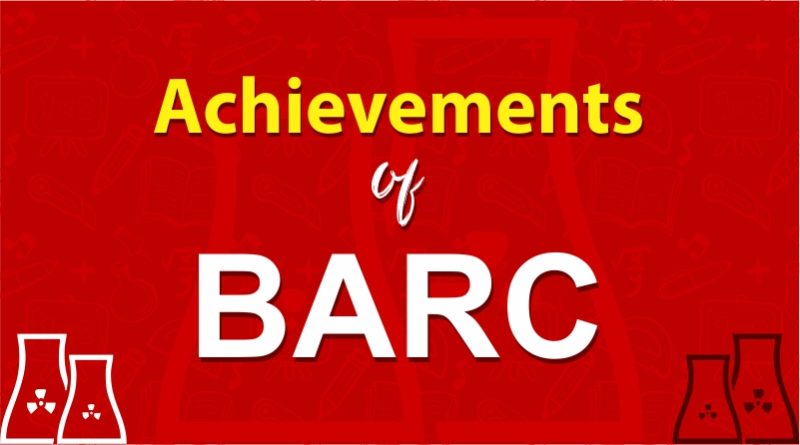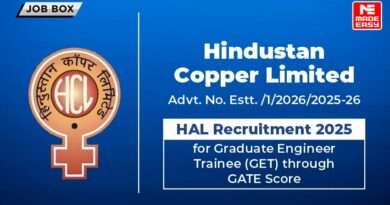Achievements of BARC
Bhabha Atomic Research Centre has recently announced recruitment and like every year, many aspirants find it a great opportunity to make their way in technical careers. Though BARC careers and BARC internship does seem to be a lucrative career option to a lot of the aspirants looking for a career in technical fields but if not all, still many of them are unaware of how Bhabha Atomic research centre came into being, how and what it does, and most importantly what are some remarkable achievements of this organization. This blog is a little effort to sum up the otherwise, incredible achievements of the renowned Bhabha Atomic Research centre.
Brief History of BARC:
When it became inevitable to India, by the early and mid-1940s that independence is coming, the country had practically no base of science or research. Just before that, in second world war, the country had seen both horrors and the power of science and research. It was then that the country’s policy makers, scientists, politicians and industrialists realized that to strive as an independent nation and to protect the country, it is almost unavoidable for India to have its own research and scientific base.
Meanwhile, Dr. Homi Jehangir Bhabha, with the help of Tatas had already established a fundamental research institute in Mumbai, known as Tata Institute of Fundamental Research (TIFR) in 1945.
After long deliberations among policy makers, Atomic Energy Act was passed in 1948. In the same light, on 3 January, 1954, Atomic Energy Establishment, Trombay (AEET) was created by The Government of India to intensify the nuclear programs and exploit nuclear energy for the betterment of the nation.
In 1966, after the demise of Dr. Bhabha, AEET was renamed Bhabha Atomic Research Centre (BARC) on 22 January 1967.
Working and role of BARC:
The BARC and the Government of India has consistently maintained that the primary importance of BARC remains only as a research centre. The Core philosophy of BARC is peaceful application of nuclear energy. Bhabha Atomic Research Centre handles all facets of nuclear power generation from designing of reactors, modelling, risk analysis and simulation.
While working together to build the nation, there have been some really great achievements of BARC. These achievements are not only something to be proud of, for all the citizens; but also, something to be inspired from, for all the new aspiring engineers to work for BARC careers and help serve their country in a better way!
Achievements of BARC:
Ever since its establishment, Bhabha Atomic Research Centre has done marvelous job in a number of fields and also made a number of achievements in the same. To reckon a few:
- BARC has till date successfully established multiple five power reactors. Earlier, the first power reactors were brought in from the USA. India is now fully equipped to carry on research and designing nuclear reactors independently. Apsara in 1956 was the first reactor. CIRUS is another reactor provided by Canada. India used the spent fuel (Converted into Plutonium) from CIRUS for 1st nuclear test in 1974.
- Pressure Heavy water Reactors (PHWRs):
Bhabha Atomic research centre designed India’s first pressurised water reactor with 80 MW capacity at Kalpakkam. Since India does not have very good resources of Uranium, thus it becomes inevitable that it uses natural uranium only.
A pressurized heavy-water reactor (PHWR) is a nuclear reactor that uses heavy water as its coolant and neutron moderator. PHWRs frequently use natural uranium as fuel, sometimes even very low enriched uranium. The heavy water’s low absorption of neutrons greatly increases the neutron economy of the reactor, avoiding the need for enriched fuel.
The high cost of the heavy water is offset by the lowered cost of using natural uranium and/or alternative fuel cycles.
- Fast Breeder Test Reactor (FBTR): DAE has been running a Fast Breeder Test Reactor for more than 20 years. India is only the seventh country to develop a breeder reactor. The best part about breeder reactors, as their name suggests, is that they produce more fuel when run than they consume.
It’s like running a car with tank half full and after travelling for 200 Km, you still have a quarter full of tank and also have supply for your Truck. In short, these reactors produce both power and fuel for a different kind of reactors. - A Prototype Fast Breeder Reactor (PFBR) of 500 MW capacity has completed construction and awaiting regulatory clearances. This will bring a new era, as after this reactor, we will be able to utilise huge reserves of Thorium available in India.
- Heavy Water Production: For controlled and sustained nuclear chain reaction, fast neutrons produced from nuclear reactors must be slowed down. Hydrogen (in water) is a very efficient moderator but it absorbs more neutrons which in turn requires relatively enriched fuel. As fuel economy is one of the prime motive of Bhabha Atomic Research center’s program, it needed Deuterium (Heavy water) as moderator which absorbs less neutrons allowing BARC to use natural uranium in PHWRs.
After initial hiccups, DAE has now mastered Heavy Water production technology. An individual unit, Heavy Water Board, looks after the production and supply of heavy water. India has now even become an exporter and have exported to many countries including USA and China.
- Nuclear Reprocessing: One very peculiar thing about nuclear power production is that most of the fuel which goes inside a reactor comes out unused. That fuel, if reprocessed, can be used again and again multiple number of times. Along with the fuel, many useful isotopes are also obtained which can be then used in a number of applications including medical applications. A nuclear power production cycle with reprocessing then reuse is known as Closed Fuel Cycle which BARC has chosen.
DAE has mastered technology of reprocessing fuel. Bhabha Atomic Research Centre has plants in multiple locations. The latest one at Tarapur, PREFRE-2, has continually been operated and has performed with more than 100% capacity. Similar plant has been planned in Kalpakkam also.
- Bhabhatron- I and II: Bhabha Atomic Research Centre has a big number of options to offer for BARC Careers and even in BARC internship. BARC results have shown success not only in research and power generation, but also contributed significantly in the field of medicine and therapy. Bhabhatron is a state of the art tele-therapy unit for cancer patients which uses a Cobalt-60 source. BARC has also developed a radiotherapy simulator to assist the doctors in ensuring that the dose is targeted and adequate. It is way more cost-effective than the similar machines used to be imported earlier. All over India, in many hospitals, it is being used to save lives of people, simultaneously, reducing the financial burden on them. Recently, the current prime minister of India, Mr. Modi also handed over a model of Bhabhatron-2 machine to a Mongolian representative for cancer treatment.
Defence:
- BARC has produced most important arsenal for the country in collaboration with other organizations. A very significant partnership, with that of ECIL has developed antenna systems, encryption system, satellite communication systems, platforms for RADARs, Missile support systems etc. which are being used in multiple ways by our defence establishments.
ECIL in association with ECI (Election commission of India) has also developed EVMs, which has significantly changed the way elections are been conducted in the country.
- KALI (Kilo Ampere Linear Injector)has been developed by Bhabha Atomic Research Centre (BARC) and Defence Research and Development Organization (DRDO) as a very high speed electron gun which can be targeted towards enemy systems such as missiles to destroy their on board electronic systems. BARC has also developed bullet proof materials which will be very helpful to India’s defence forces.
- Water Technologies: BARC has developed multiple technologies ranging from cleaning water to finding the flow path of ground water. Low cost domestic water purifier has also been developed which kills bacteria up to >99.99% that too without need of electricity, harmful chemicals or wastage of water. The technology has been transferred to many parties and the country’s citizens are continuously being benefited by that.
- A large scale Nuclear Desalination Demonstration Plant (NDDP), near Chennai, which uses multi stage flash evaporation and reverse osmosis technologies has been running for more than a decade. It is coupled to Madras Atomic Power Station(MAPS) and cleans nearly 6.3 million litres of water every day.
Similar projects are being planned by Bhabha Atomic Research Center in future and engineers and aspirants can find potential options of BARC Careers and BARDC internships in the same.
- Waste Management: BARC has developed solid waste management solution with the philosophy of zero effluent and zero garbage. Nisagruna (Nisarg + Runa = Nature’s debt) is a biogas plant developed by BARC, which has been installed in 100s of places and is continuously being installed in new locations. It produces methane which is then used for cooking purposes and the leftover manure with high nitrogen content is used for soil conditioning.
Though there are many more or maybe uncountable things that such institutes achieve in fields of fundamental research, astronomy, medical sciences, solar energy, accelerators, vacuum instruments, soil testing, etc. on a daily basis, we can only enlist a few to re-establish and remember how important it is for the country’s development.
BARC careers and even BARC internships are a great way to start a bright future for the aspirants for themselves as well as the country. Since BARC has recently announced recruitment and a lot of aspirants are showing great enthusiasm for the same, MADE EASY wishes all the aspirants the very best!
Read More Article About BARC:
- BARC: All about Bhabha Atomic Research Centre
- BARC Recruitment through GATE 2019-20
- BARC Training School: Detailed Training Procedure
- Why Choose BARC as a Career?
Dear Aspirants,
Your preparation for GATE, ESE, PSUs, and AE/JE is now smarter than ever — thanks to the MADE EASY YouTube channel.
This is not just a channel, but a complete strategy for success, where you get toppers strategies, PYQ–GTQ discussions, current affairs updates, and important job-related information, all delivered by the country’s best teachers and industry experts.
If you also want to stay one step ahead in the race to success, subscribe to MADE EASY on YouTube and stay connected with us on social media.
MADE EASY — where preparation happens with confidence.

MADE EASY is a well-organized institute, complete in all aspects, and provides quality guidance for both written and personality tests. MADE EASY has produced top-ranked students in ESE, GATE, and various public sector exams. The publishing team regularly writes exam-related blogs based on conversations with the faculty, helping students prepare effectively for their exams.



